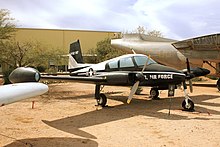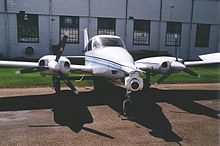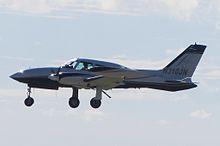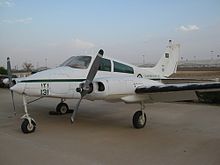avia.wikisort.org - Aeroplane
The Cessna 310 is an American four-to-six-seat, low-wing, twin-engine monoplane produced by Cessna between 1954 and 1980. It was the first twin-engine aircraft that Cessna put into production after World War II.[1]
| Cessna 310 / 320 | |
|---|---|
 | |
| Cessna 310 | |
| Role | Twin-engine cabin monoplane |
| Manufacturer | Cessna |
| First flight | January 3, 1953 |
| Introduction | 1954 |
| Primary user | United States Air Force |
| Produced | 1954–1980 |
| Number built | 5,449 (310) 577 (320) |
Development
The 310 first flew on January 3, 1953, with deliveries starting in late 1954. The sleek modern lines of the new twin were backed up by innovative features such as engine exhaust thrust augmenter tubes and the storage of all fuel in tip tanks in early models. In 1964, the engine exhaust was changed to flow under the wing instead of the augmenter tubes, which were considered to be noisy.[1]
Typical of Cessna model naming conventions, a letter was added after the model number to identify changes to the original design over the years. The first significant upgrade to the 310 series was the 310C in 1959, which introduced more powerful 260 hp (194 kW) Continental IO-470-D engines. In 1960 the 310D featured swept-back vertical tail surfaces. An extra cabin window was added with the 310F.[1]










The turbocharged 320 Skyknight was developed from the 310F. Equipped with TSIO-470-B engines and featuring an extra cabin window on each side, it was in production between 1961 and 1969 (the 320E was named the Executive Skyknight), when it was replaced by the similar Turbo 310.[1][2]
The 310G was certified in 1961[3] and introduced the canted wingtip fuel tanks found on the majority of the Cessna twin-engine product line, marketed as "stabila-tip" tanks by Cessna, because they were meant to aid stability in flight. A single side window replaced the rear two windows on the 310K (certified in late 1965), with optional three-blade propellers being introduced as well.[4] Subsequent developments included the 310Q and turbocharged T310Q with a redesigned rear cabin featuring a skylight window, and the final 310R and T310R, identifiable by a lengthened nose containing a baggage compartment. Production ended in 1980.[1]
Over the years there were several modifications to the 310 to improve performance. Noted aircraft engineer Jack Riley produced two variants, The Riley Rocket 310 and the Riley Turbostream 310. Riley replaced the standard Continental 310 hp (230 kW) engines with 350 hp (261 kW) Lycoming TIO-540 engines. These turbocharged intercooled engines were installed with three-blade Hartzell propellers in a counter-rotating configuration to further increase performance and single-engine safety. At 5,400 lb (2,400 kg) gross weight the aircraft had a weight to power ratio of 7.71 lb (3.50 kg) per horsepower. This resulted in a cruising speed of 260 knots (480 km/h; 300 mph) at 18,000 feet (5,500 m) and a 3,000 ft/min (15 m/s) rate of climb.
Operational history
Commercial applications
The Cessna 310 was a common charter aircraft for the many air taxi firms that sprang up in the general aviation boom that followed World War II. The advantages of the Cessna 310 over its contemporaries, such as the Piper PA-23, were its speed, operating costs and aftermarket modifications, such as the Robertson STOL kits that made it popular worldwide for its bush flying characteristics. It could use short runways, while at the same time carrying a large useful load of 2,000 lb (910 kg). or more, at speeds that were high for a twin engine piston aircraft.
Military applications
In 1957, the United States Air Force (USAF) selected the Cessna 310 for service as a light utility aircraft for transport and administrative support. The USAF purchased 160 unmodified 310A aircraft with the designation L-27A and unofficially nicknamed Blue Canoe,[5] later changed to U-3A in 1962. An additional 36 upgraded 310 designated L-27B (later U-3B) were delivered in 1960–61; these aircraft were essentially military 310Fs and as such equipped with the more powerful 260 hp (194 kW) engines and can be identified by their extra cabin windows, longer nose and swept vertical fin. A USAF study after one year of operational service found the U-3A had direct operating costs of less than $12 an hour.[6] The U-3 saw active service in a support role when the USAF deployed aircraft to South Vietnam during the Vietnam War, where they were used on courier flights between air bases.[7][8] Some USAF aircraft were later transferred to the U.S. Army and U.S. Navy and the type continued in United States military service into the mid-1970s.
Notable private flights
On December 19, 1992, Cuban defector Major Orestes Lorenzo Pérez returned to Cuba in a 1961 Cessna 310 to retrieve his wife and two sons. Flying without lights, at low speed and very low altitude to avoid Cuban radar, Pérez picked up his family by landing on the coastal highway of Varadero beach, Matanzas Province, 93 mi (150 km) east of Havana and managed a successful safe return to Marathon, Florida.[9][10]
Variants
- 310
- Initial production variant, powered by two 240 hp (180 kW) Continental O-470-B or O-470-M engines with carburetors, with maximum takeoff weight of 4,600 pounds (2,100 kg);[11] in production for 1955-1957 model years, 547 built.[12]
- 310A
- Military version of the 310 for the United States Air Force, designated L-27A and later U-3A; with Continental O-470-M engines and maximum takeoff weight of 4,830 pounds (2,190 kg);[13] 161 built.[14]
- 310B
- Model produced in 1958,[12] with new instrument panel,[citation needed] O-470-M engines and maximum takeoff weight of 4,700 pounds (2,100 kg);[15] 225 built.[12][16]
- 310C
- Model produced in 1959,[12] with 260 hp (190 kW) Continental IO-470-D fuel-injected engines and maximum takeoff weight increased to 4,830 pounds (2,190 kg);[17] and minor changes; 260 built.[18] Unit cost $59,950 in 1959[19]
- 310D
- First model with swept vertical tail,[20] other minor detail changes;[citation needed] 268 built for 1960 model year.[12]
- 310E
- Military version of the 310F,[citation needed] designated the L-27B and later U-3B; with maximum takeoff weight of 4,990 pounds (2,260 kg);[21] 36 built.[22]
- 310F
- Model produced in 1961,[12] with extra cabin window each side, pointed nose and other minor changes;[citation needed] maximum takeoff weight of 4,830 pounds (2,190 kg); 155 built.[23]
- 310G
- First model with canted slimline tip tanks and optional six-seat cabin,[citation needed] with maximum takeoff weight increased to 4,990 pounds (2,260 kg)[3] and detail changes,[citation needed] 156 built in 1962.[12]
- 310H
- Model produced in 1963 with maximum takeoff weight increased to 5,100 pounds (2,300 kg)[12][24] and enlarged cabin interior.[citation needed]
- E310H
- Version of 310H with the 4,990-pound (2,260 kg) maximum takeoff weight of the 310G;[25] combined total of 148 310H and E310H built.[12]
- 310I
- First model with baggage compartments in rear of engine nacelles, Continental IO-470-U engines[26] and minor detail changes;[citation needed] 200 built in 1964.[12]
- 310J
- Model produced in 1965[12] with minor detailed changes[citation needed] and maximum takeoff weight of 5,100 pounds (2,300 kg).[26]
- 310J-1
- Version of 310J type-certified in the Utility Category; with maximum takeoff weight increased to 5,150 pounds (2,340 kg); seating limited to four people instead of the 310J's six; and reduced baggage weight limit.[27]
- E310J
- Version of 310J with maximum takeoff weight reduced to 4,990 pounds (2,260 kg);[28] combined total of 200 310J, 310J-1 and E310J built.[12][29]
- 310K
- First model with optional three-blade propellers[4] and long 'vista view' side windows;[citation needed] also increased maximum takeoff weight of 5,200 pounds (2,400 kg) with IO-470-V or IO-470-VO engines;[30] 245 built in 1966.[12]
- 310L
- First model with increased fuel capacity via fuel tanks inside wings and optional fuel tanks in engine nacelles,[31] also single-piece windshield, redesigned landing gear, and minor changes;[32] 207 built in 1967.[12]
- 310M
- Revised designation for the 310E.[citation needed]
- 310N
- Model produced in 1968,[12] with revised instrument panel and provision for optional cargo door and fuel;[33] 198 built.[12]
- 310P
- Model produced in 1969,[34] with Continental IO-470-VO engines,[35] ventral fin and a shorter nose gear leg.[36]
- T310P
- Version of 310P with turbocharged Continental TSIO-520-B or TSIO-520-BB engines producing 285 hp (213 kW) and maximum takeoff weight of 5,400 pounds (2,400 kg);[37] combined total of 240 310P and T310P built.[34]
- 310Q
- Last short-nose model, introduced in 1970,[34] with maximum takeoff weight increased to 5,300 lb (2,400 kg)[38] and detailed changes, from the 401st aircraft fitted with a bulged rear cabin roof with rear view window.[citation needed]
- T310Q
- Version of 310Q with turbocharged Continental TSIO-520-B or TSIO-520-BB engines and maximum takeoff weight increased to 5,500 lb (2,500 kg);[39] combined total of 871 310Q and T310Q built.[34]
- 310R
- Last production model, introduced in the 1975 model year,[40] with 285 hp (213 kW) Continental IO-520-M or IO-520-MB engines; three-blade propellers as standard; lengthened nose containing a baggage compartment; and 5,500 lb (2,500 kg) maximum takeoff weight.[41]
- T310R
- Version of 310R with turbocharged Continental TSIO-520-B or TSIO-520-BB engines;[42] combined total of 1,332 310R and T310R built.[40]
- 310S
- Original designation for the Cessna 320.[citation needed]
- 320 Skyknight
- Enlarged version of the 310F with six seats, larger cabin and two turbocharged engines; 110 built.
- 320A Skyknight
- First model with canted fuel tanks and minor changes; 47 built.
- 320B Skyknight
- First model with nacelle baggage lockers, minor changes; 62 built.
- 320C Skyknight
- Model with a longer cabin, optional seventh seat and minor changes; 73 built.
- 320D Executive Skyknight
- Model with reshaped rear windows and 285 hp (213 kW) TSIO-520-B engines; 130 built.
- 320E Executive Skyknight
- Model with pointed nose, single piece windshield, modified landing gear, increased takeoff weight and minor changes; 110 built.
- 320F Executive Skyknight
- Model with minor changes compared to 320E; 45 built.
- L-27A
- United States military designation for the 310A, later changed to U-3A.
- L-27B
- United States military designation for the 310E/310M, later changed to U-3B.
- U-3A
- L-27A redesignated in 1963.
- U-3B
- L-27B redesignated in 1963.
- Colemill Executive 600
- Conversion of models 310F to 310Q, replacing the engines with 350 hp (260 kW) Lycoming TIO-540-J2BDs driving four-bladed propellers.[43]
- Riley 65
- Conversion offered for models 310 to 310G, replacing the engines with two 240-260 hp (179–194 kW) Continental O-470Ds or -470Ms.[44]
- Riley Super 310
- Conversion of Cessna 310/320 by fitting two 310 hp (231 kW) Continental TSIO-520J or 520N engines.[45]
- Riley Turbostream
- Conversion of Cessna 310 by fitting two 350 hp Lycoming engines.[46]
- Riley Rocket
- Conversion of Cessna 310 by fitting two 290 hp (216 kW) Lycoming IO-540-A1A5 engines and more fuel capacity.[44]
- Riley Turbo-Rocket
- Riley Rocket with each engine fitted with two Riley-manufactured turbochargers. Cruise speed increased from 252 mph (219 kn; 406 km/h) to 302 mph (262 kn; 486 km/h).[47]
Operators
Civil
The aircraft is popular with air charter companies and small feeder airlines, and is operated by private individuals and companies.
Military operators
Countries known to have operated the U-3/310 include.

- Argentina
- Argentine Air Force — Cessna 310 and 320 models[5]
- Bolivia[5]
- Colombia
- Colombian Air Force[48]
- Republic of the Congo[5]
- France
- Haiti
- Haiti Air Corps[5]
- Indonesia
- Iran[5]
- Madagascar
- Air Force of Madagascar — One 310R[51]
- Mexico
- Mexican Naval Aviation[52]
- Paraguay
- Paraguayan Air Force[53]
- Peru
- Peruvian Navy[54]
- Philippines
- Philippine Air Force[55]
- Saudi Arabia[5]
- Suriname
- Tanzania
- United States
- United States Air Force received 196 L-27A and L-27B (later redesignated U-3A and B).[58]
- United States Army received 25 ex-US Air Force L-27As (later U-3As) and at least 13 L-27Bs (later U-3B) from 1960.[59]
- Uruguay
- Uruguayan Air Force (One 310R)[60]
- Venezuela
- Venezuelan Navy[61]
- Zaire
- Zaire Air Force[62]
Accidents and incidents
- On October 28, 1959, a Cessna 310 carrying Cuban revolutionary Camilo Cienfuegos disappeared over the Atlantic Ocean on a night flight from Camagüey to Havana. Neither the aircraft nor the body of Cienfuegos were ever found.[63]
- On November 26, 1962, a Saab Scandia 90A-1 (registration PP-SRA) of VASP on a scheduled domestic service in Brazil from São Paulo-Congonhas to Rio de Janeiro-Santos Dumont collided in the air over the Municipality of Paraibuna, State of São Paulo with a private Cessna 310 registration PT-BRQ en route from Rio de Janeiro-Santos Dumont to São Paulo-Campo de Marte. Both were flying on the same airway in opposite directions and failed to have visual contact. The two aircraft crashed killing all 23 passengers and crew of the Saab and the four occupants of the Cessna.[64][65]
- On July 19, 1967, a Boeing 727 operating as Piedmont Airlines Flight 22 collided with a Cessna 310 near Hendersonville, North Carolina in the US, killing all 79 people on board the Boeing 727 and the three people in the Cessna.[66]
- On October 16, 1972, US Congressmen Nick Begich of Alaska, and Hale Boggs of Louisiana, disappeared over Alaska while flying in a 310C during a campaign trip.[67][68]
- On September 11, 1981, the Swing Auditorium in San Bernardino, California was irreparably damaged when it was struck by a twin-engine Cessna T310P, following which the building had to be razed.[69][70]
- On June 29, 1989, concert organist Keith Chapman and his wife were killed when their 310Q piloted by Chapman crashed into the Sangre de Cristo Mountains of the Colorado Rockies while they were returning from a performance in California.[71][72]
As of July 2017[update], the US National Transportation Safety Board has recorded 1,787 incidents for Cessna 310s since 12 January 1964. Of these, 436 were fatal.[73]
Specifications (1956 model 310)


Data from 1956 Observers Book of Aircraft[74]
General characteristics
- Crew: one
- Capacity: four passengers
- Length: 27 ft 0 in (8.23 m)
- Wingspan: 35 ft 0 in (10.67 m)
- Height: 10 ft 6 in (3.20 m)
- Wing area: 175 sq ft (16.3 m2) [75]
- Empty weight: 2,850 lb (1,293 kg)
- Gross weight: 4,600 lb (2,087 kg)
- Fuel capacity: 100 US gal (83 imp gal; 380 L)[75]
- Powerplant: 2 × Continental O-470-B horizontally opposed piston engine, 240 hp (180 kW) each
Performance
- Maximum speed: 220 mph (350 km/h, 190 kn)
- Cruise speed: 205 mph (330 km/h, 178 kn)
- Range: 1,000 mi (1,600 km, 870 nmi)
- Service ceiling: 20,000 ft (6,100 m)
- Rate of climb: 1,700 ft/min (8.6 m/s)
Notable appearances in media
See also
Aircraft of comparable role, configuration, and era
- Beagle B.206
- Beechcraft Baron
- Beechcraft Travel Air
- Beechcraft Twin Bonanza
- Let L-200 Morava
- Piper PA-23
- Piper PA-34 Seneca
References
- Demand Media (2008). "The Cessna 310/320". Archived from the original on April 9, 2008. Retrieved May 4, 2008.
- Keith Connes (October 1979). "Turbo 310". Air Progress: 39.
- Type Certificate 3A10, p. 11.
- Type Certificate 3A10, p. 19.
- Krivinyi, Nikolaus: World Military Aviation, page 148. Arco Publishing Co., 1977. ISBN 0-668-04348-2
- Phillips, Edward H:Wings of Cessna Model 120 to the Citation III, Flying Books, 1986. ISBN 0-911139-05-2
- Harvey 1966, p. 69.
- Harvey 1966, p. 80.
- Google News, Top Cuban Pilot Defects to US Archived 2016-04-29 at the Wayback Machine The Deseret News, 21 March 1991, retrieved 5 January 2012
- Cuban Pilot Who Defected Flies Back for Family Archived 2017-01-26 at the Wayback Machine The New York Times, 21 December 1992, retrieved 29 June 2017
- Type Certificate 3A10, pp. 1–2.
- "Cessna 310". Aircraft Bluebook. Penton. Summer 2017. Archived from the original on August 9, 2017. Retrieved June 19, 2017.
- Type Certificate 3A10, pp. 2–3.
- Type Certificate 3A10, p. 3.
- Type Certificate 3A10, p. 4.
- Type Certificate 3A10, p. 5.
- Type Certificate 3A10, pp. 5–6.
- Type Certificate 3A10, p. 6.
- "New 220-Mph Cessna: 5 Cabin Choices, "Engine Silencer", Fuel-Injection!". Advert. Flying. Vol. 64, no. 1. January 1959. pp. 60–61.
- Cessna 310 thru 310D (1955-1960) Maintenance Manual, Section 6-10-00. Retrieved June 24, 2017
- Type Certificate 3A10, p. 8.
- Type Certificate 3A10, p. 9.
- Type Certificate 3A10, p. 10.
- Type Certificate 3A10, p. 13.
- Type Certificate 3A10, p. 14.
- Type Certificate 3A10, p. 15.
- Type Certificate 3A10, pp. 16–18.
- Type Certificate 3A10, p. 18.
- Type Certificate 3A10, pp. 17–19.
- Type Certificate 3A10, pp. 19–20.
- Type Certificate 3A10, p. 21.
- Taylor 1967, p. 238.
- Taylor 1968, p. 254.
- "Cessna 310P and up". Aircraft Bluebook. Penton. Summer 2017. Archived from the original on August 9, 2017. Retrieved June 19, 2017.
- Type Certificate 3A10, p. 23.
- Taylor 1969, p. 301.
- Type Certificate 3A10, pp. 24–25.
- Type Certificate 3A10, p. 27.
- Type Certificate 3A10, pp. 28–29.
- "Cessna 310R (1975 and up)". Aircraft Bluebook. Penton. Summer 2017. Archived from the original on August 9, 2017. Retrieved June 19, 2017.
- Type Certificate 3A10, pp. 29–31.
- Type Certificate 3A10, p. 31.
- Mitchell 1994, p. 305.
- Taylor 1966, p. 314.
- Taylor 1982, pp. 453–454.
- "The Man Who Invented the STC". Air Progress: 29. September 1989.
- Taylor 1967, p. 340.
- Forster World Air Power Journal Autumn 1997, p. 136.
- Andrade 1982, p. 67.
- Andrade 1982, p. 106.
- Andrade 1982, p. 151.
- Andrade 1982, p. 157.
- "Paraguay's Military: Internal Security Challenges vs Bloc Obsolescence | Manohar Parrikar Institute for Defence Studies and Analyses". idsa.in.
- Andrade 1982, p. 179.
- Andrade 1982, p. 180.
- "Cessna 310 | Suriname Air Force".
- Andrade 1982, p. 222.
- Taylor 1982, p. 347.
- Harding 1990, pp. 85–86.
- Andrade 1982, p. 336.
- Andrade 1982, p. 339.
- Andrade 1982, p. 342.
- Thomas, Hugh. 1970,1998. Cuba: The Pursuit of Freedom, pp. 842–3. Da Capo Press, New York. ISBN 0-306-80827-7
- "Accident description PP-SRA and PT-BRQ". Aviation Safety Network. Archived from the original on November 4, 2012. Retrieved June 2, 2011.
- Germano da Silva, Carlos Ari César (2008). "No céu de Paraibuna". O rastro da bruxa: história da aviação comercial brasileira no século XX através dos seus acidentes 1928–1996 (in Portuguese) (2 ed.). Porto Alegre: EDIPUCRS. pp. 214–216. ISBN 978-85-7430-760-2.
- Aviation Safety Network (June 2006). "Accident description". Archived from the original on June 25, 2011. Retrieved July 25, 2009.
- "Aircraft Accident Report Pan Alaska Airways, Ltd. Cessna 310C, N1812H" (PDF). National Transportation Safety Board. January 31, 1973. Archived (PDF) from the original on April 22, 2012. Retrieved July 27, 2017.
- "Hale Boggs — Missing in Alaska". Famous Missing Aircraft. Check-Six. Archived from the original on February 13, 2012. Retrieved February 17, 2012.
- "The San Bernardino County Sun". The San Bernardino County Sun. September 12, 1981. p. 1. Retrieved October 1, 2019.
- Sublette, Mark (July 27, 2019). "ASN Wikibase Occurrence # 9026". Aviation Safety Network. Retrieved October 1, 2019.
- "Acclaimed organist dies in plane crash". UPI. July 4, 1989. Archived from the original on January 17, 2019. Retrieved January 16, 2019.
- "NTSB Report No. DEN89FA154". National Transportation Safety Board. Archived from the original on December 14, 2018. Retrieved January 16, 2019.
- National Transportation Safety Board (July 27, 2017). "Summary of Cessna 310 accidents". Archived from the original on December 22, 2018. Retrieved July 27, 2017.
- Green, William: Observers Book of Aircraft, page 56. Frederick Warne Publishing, 1956.
- Bridgman 1956, p. 248.
- FAA Type Certificate Data Sheet Number 3A10
- Andrade, John. Militair 1982. London: Aviation Press Limited, 1982. ISBN 0-907898-01-7
- Bridgman, Leonard. Jane's All The World's Aircraft 1956–57. New York: The McGraw-Hill Book Company, Inc., 1956.
- Foster, Peter R. (Autumn 1997). "Air Power Analysis: Part One: Columbia, Ecuador, French Guyana, Guyana, Peru, Surinam and Venezuela". World Air Power Journal. Vol. 30. pp. 132–157. ISBN 1-86184-004-7. ISSN 0959-7050.
- Harding, Stephen. U.S. Army Aircraft Since 1947. Shrewsbury, UK: Airlife Publishing, 1990. ISBN 1-85310-102-8.
- Harvey, Frank (November 1966). "The Air War in Vietnam". Flying. New York: Ziff-Davis Publishing Company. pp. 38–95.
- Michell, Simon. Jane's Civil and Military Aircraft Upgrades 1994–95. Coulsdon, UK: Jane's Information Group, 1994. ISBN 0-7106-1208-7.
- Taylor, John W. R. Jane's All The World's Aircraft 1966–67. London: Sampson Low, Marston & Company, 1966.
- Taylor, John W. R. Jane's All The World's Aircraft 1967–68. London: Sampson Low, Marston & Company, 1967.
- Taylor, John W. R. Jane's All The World's Aircraft 1968–69. London: Sampson Low, Marston & Company, 1968.
- Taylor, John W. R. Jane's All The World's Aircraft 1969–70. London: Sampson Low, Marston & Company, 1969.
- Taylor, John W. R. Jane's All The World's Aircraft 1982–83. London: Jane's Yearbooks, 1982. ISBN 0-7106-0748-2.
External links
На других языках
[de] Cessna 310
Die Cessna 310 und Cessna 320 sind zweimotorige Flugzeuge von Cessna.- [en] Cessna 310
[fr] Cessna 310
Le Cessna 310 est un avion bimoteur de transport léger et de tourisme conçu et réalisé aux États-Unis dans les années 1950. Il s'agit d'un des aéronefs les plus prolifiques de sa catégorie.[it] Cessna 310
Il Cessna 310 era un bimotore da turismo ad ala bassa prodotto dall'azienda statunitense Cessna Aircraft Company negli anni cinquanta.[ru] Cessna 310
Cessna 310 — лёгкий двухмоторный моноплан, который производился компанией Cessna с 1954 по 1980 год. Это был первый двухмоторный самолёт компании Cessna, запущенный после Второй мировой войны.Другой контент может иметь иную лицензию. Перед использованием материалов сайта WikiSort.org внимательно изучите правила лицензирования конкретных элементов наполнения сайта.
WikiSort.org - проект по пересортировке и дополнению контента Википедии